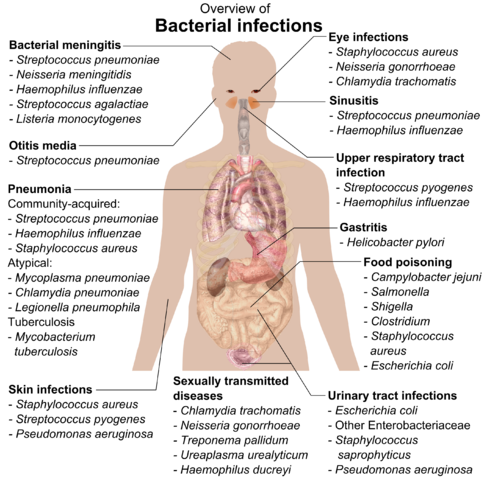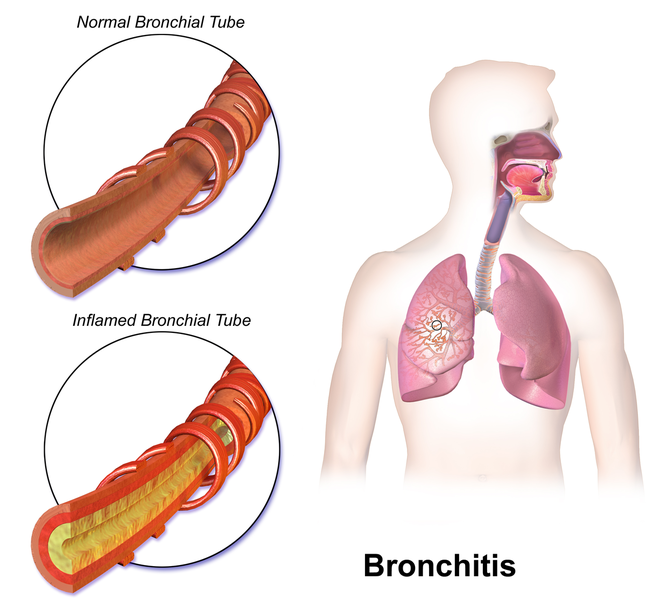Difference Between Upper Respiratory Infection and Bronchitis
The diseases of the respiratory system are generally divided into infections of the upper and lower respiratory tract. The infections of the upper respiratory tract are:
- Rhinitis;
- Pharyngitis;
- Tonsillitis, etc.
The infections of the lower respiratory tract are:
- Tracheitis,
- Bronchitis,
- Pneumonia, etc.

What is Upper Respiratory Infection?
The infections of the upper respiratory tract are mild infectious diseases that occur with upper respiratory tract inflammation. The upper respiratory tract includes the following structures: nose, pharynx, tonsils, sinuses, and larynx. They direct the inspired air to the trachea and lungs.
The disease process can affect any part of the upper respiratory tract, and the symptoms vary. Symptoms generally include a runny nose or excessive nasal discharge, tearing eyes (conjunctivitis), sore throat, breathing difficulties, nausea, diarrhea, vomiting, fever, sneezing, cough, pain in the body, etc.
Depending on the affected part of the upper respiratory tract the infections are:
- Laryngitis – inflammation of the larynx;
- Rhinitis – inflammation of the nasal cavity;
- Sinusitis – inflammation of the sinuses;
- Nasopharyngitis – inflammation of the nasal cavity, pharynx, and hypopharynx;
- Pharyngitis – inflammation of the pharynx, etc.
A major etiological factor in the upper respiratory tract infections are the viruses. The role of bacteria and mycoplasms is less significant. Bacteria rarely cause primary illness. More often they cause secondary complications of viral infections. Bacteria are the major etiological agent of the complications of upper respiratory tract infections.
Infectious agents fall into the upper respiratory tract by aerogenic route. Once the virus overcomes the local protection, it penetrates the cells of the mucous membrane and damages or destroys them. The mucosa becomes hyperemic, swollen, its glands are secreting heavily. This determines the clinical manifestations and creates conditions for the bacterial invasion that underlies the complications.
Typically, the upper respiratory tract infections are transmitted by air-droplets, and the most affected are people with a weak immune system, and those visiting kindergartens, schools, hospitals. These infections are more typical for the autumn-winter season.
Upper respiratory infections are mostly treated for the relief of symptoms. The treatment can include the use of expectorants, cough suppressants, zinc, and vitamin C to shorten the duration and reduce the symptoms. Nasal decongestants are used to improve breathing. If the cause is bacteria, antibiotics may be prescribed.

What is Bronchitis?
Bronchitis is an inflammation of the mucosa of the bronchi – the large airways connecting the trachea and lungs.
The inflammation leads to swelling and thickening that narrows the airways in the lungs. This causes disturbance of the air flow through the bronchial tree and breathing difficulties, severe cough accompanied by thick mucus and air deficiency. The inflamed mucous membrane is red, swollen, covered with exudate.
Bronchitis may be acute or chronic. Acute bronchitis heals for a relatively short time – from a few days to a few weeks, but left untreated or due to external factors such as smoking, it can become chronic (symptoms persist or recur frequently).
Bronchitis is a relatively common disease, especially in children.
In most cases, acute bronchitis is due to a viral infection, but the cause may also be a bacterial infection. Acute bronchitis causes a dry cough with bronchial secretion. In case the overall health status of the patient is good, the bronchial mucosa will recover completely after eliminating the primary infection.
Chronic bronchitis is a serious long-term illness that often requires regular medication. The primary reason for the occurrence of chronic bronchitis is smoking. Other causes of chronic bronchitis include air pollution, occupational dangers, climatic factors, chronic sinus infection, allergies, etc.
The treatment of bronchitis may include cough suppressants, bronchodilators, sleeping near a humidifier, pain relievers. If the cause is bacteria, antibiotics may be prescribed.
Difference Between Upper Respiratory Infection and Bronchitis
-
Definition
Upper Respiratory Infection: The infections of the upper respiratory tract are mild infectious diseases that occur with upper respiratory tract inflammation.
Bronchitis: Bronchitis is an inflammation of the mucosa of the bronchi.
-
Affected structures
Upper Respiratory Infection: The upper respiratory tract includes the following structures: nose, pharynx, tonsils, sinuses, and larynx.
Bronchitis: The bronchitis affects the bronchi – the large airways connecting the trachea and the lungs.
-
Symptoms
Upper Respiratory Infection: The symptoms of upper respiratory infection generally include a runny nose or excessive nasal discharge, tearing eyes (conjunctivitis), sore throat, breathing difficulties, nausea, diarrhea, vomiting, fever, sneezing, cough, pain in the body, etc.
Bronchitis: The symptoms of bronchitis include breathing difficulties, severe cough accompanied by thick mucus and air deficiency, etc.
-
Types
Upper Respiratory Infection: Depending on the affected part of the upper respiratory tract the infections are laryngitis, rhinitis, sinusitis, nasopharyngitis, pharyngitis, laryngotracheitis, etc.
Bronchitis: Depending on the duration, bronchitis may be acute or chronic.
-
Etiology
Upper Respiratory Infection: The major etiological factor in the upper respiratory tract infections are the viruses. The role of bacteria and mycoplasms is less significant.
Bronchitis: In most cases, acute bronchitis is due to a viral infection, but the cause may also be a bacterial infection. The primary reason for the occurrence of chronic bronchitis is smoking.
-
Treatment
Upper Respiratory Infection: The treatment of upper respiratory infections can include the use of expectorants, cough suppressants, zinc, and vitamin C to shorten the duration and reduce the symptoms. Nasal decongestants are used to improve breathing. If the cause is bacteria, antibiotics may be prescribed.
Bronchitis: The treatment of bronchitis may include cough suppressants, bronchodilators, sleeping near a humidifier, pain relievers. If the cause is bacteria, antibiotics may be prescribed.
Upper Respiratory Infection Vs. Bronchitis

Summary of Upper Respiratory Infection Vs. Bronchitis
- The infections of the upper respiratory tract are mild infectious diseases that occur with upper respiratory tract inflammation. The upper respiratory tract includes the nose, pharynx, tonsils, sinuses, and larynx.
- Bronchitis is an inflammation of the mucosa of the bronchi – the large airways connecting the trachea and the lungs.
- The symptoms of upper respiratory infection include a runny nose or excessive nasal discharge, tearing eyes, sore throat, breathing difficulties, nausea, diarrhea, vomiting, fever, sneezing, cough, pain in the body, etc. The symptoms of bronchitis include breathing difficulties, severe cough accompanied by thick mucus and air deficiency, etc.
- Depending on the affected part of the upper respiratory tract, the infections are laryngitis, rhinitis, sinusitis, nasopharyngitis, pharyngitis, laryngotracheitis, etc. Depending on the duration, bronchitis may be acute or chronic.
- The major etiological factor in the upper respiratory tract infections and bronchitis are the viruses. The role of bacteria is less significant. The primary reason for the occurrence of chronic bronchitis is smoking.
- The treatment of upper respiratory infections can include the use of expectorants, cough suppressants, zinc, vitamin C, nasal decongestants, antibiotics, etc. The treatment of bronchitis may include cough suppressants, bronchodilators, sleeping near a humidifier, pain relievers, antibiotics, etc.
- Difference Between Gallstones and Cholecystitis - September 5, 2021
- Difference Between Constipation and Cramping - August 4, 2021
- Difference Between Whole Genome Sequencing and Microarray - May 6, 2021
Search DifferenceBetween.net :
Leave a Response
References :
[0]Haas, F., S. Haas, R. Human. The Chronic Bronchitis and Emphysema Handbook. 1st Edition. New York, Toronto: John Wiley and Sons, Inc. 2000. Print.
[1]Warrell, D., T. Cox, J. Firth. Oxford Textbook of Medicine, Vol. 2. Oxford: Oxford University Press. 2010. Print
[2]Yankova, Z. New Guide to Pulmonary Diseases and Tuberculosis. Sofia: Medical University Press. 2012. Print.
[3]Image credit: https://upload.wikimedia.org/wikipedia/commons/thumb/9/9c/Bacterial_infections_and_involved_species.png/487px-Bacterial_infections_and_involved_species.png
[4]Image credit: https://upload.wikimedia.org/wikipedia/commons/thumb/1/1c/Bronchitis.png/646px-Bronchitis.png
